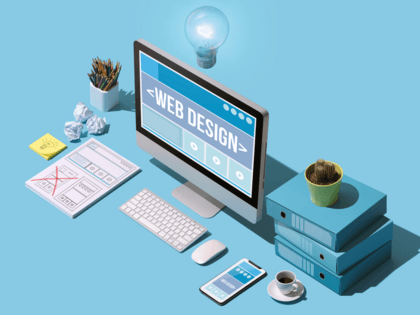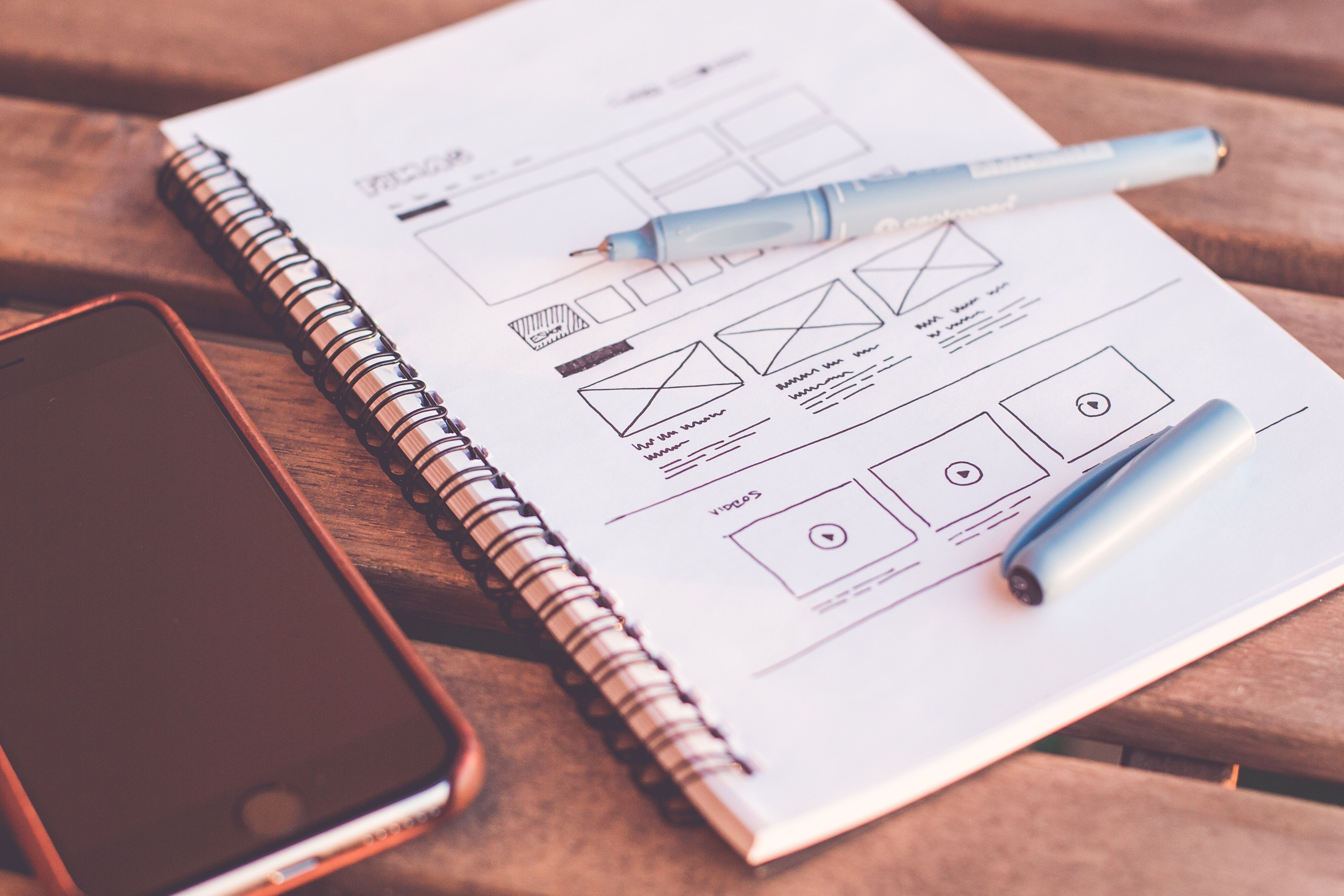Best Web Design Process (10 Simple Steps For Success)

- Summary
- 1. Start with a Great Team
- 2. Gauging Project Scope
- 3. Wireframes and Mockups
- 4. Content. Content. Content.
- 5. Visuals and Photos
- 6. Continual Communication
- 7. Web Development
- 8. First Draft
- 9. Launching a Site
- 10. Maintenance and Support
- Web Design Process Checklist
- Popular Alternative Web Design Processes
- Web Design Process Best Practices
- The Ever-Changing Web Design Process
Make sure it’s eye-catching, ensure you’re guaranteeing site visitors a pleasant user experience, and boom, it’s done. Here’s your new website.
Sounds so simple, right? But the reality is that the web design process is anything but simple. To give you a better idea of what to expect from a premier website design team, the following is an in-depth peek into the world of website development with 10 simple steps for success—from a pro’s perspective.
What does a step-by-step web design process look like?
Every team will have its own process. The team at O8 is made up of senior developers and high-tech industry veterans. We utilize best practices to design sites that are exciting, engaging, technically sound, and future-proof.
This is how.
1. Start with a Great Team
It’s probably safe to say that any product can only be as good as the team who creates it. And since you want a great website, it follows that you need to start with a great team. One that knows and executes the web design process from A to Z. Or in this case, 1 to 10.
Okay, so what makes a great team?
It’s not just about the hard—technical—skills, but let’s start with that.

Team Structure
Teams may differ. There are different design processes, so the structure of a team may be unique to a specific process. However, the following roles are common:
-
Project Manager
-
Project Architect
-
Backend Developer
-
Frontend Developer
-
UI/UX Designer
-
QA Engineer
Project Manager
When you hire a web development team, there’s a chance you’ll be assigned a project manager or CXL. Their job is to ensure you get your project delivered on time. Just like a conductor keeps an orchestra on time and in sync, a project manager coordinates the website design process.
A few project manager responsibilities include:
-
Working with the team to develop a roadmap for the web design project
-
Maintaining communication between developers and customers
-
Keeping the client up to date on progress and managing deliverables
-
Troubleshooting when necessary
-
Managing risk
Project Architect or Strategist
For teams that don’t have a dedicated Project Architect, this role often falls under the Project Manager’s duties.
It’s the PA’s job to oversee the project from the initial development stages. After identifying the needs of the client, they conceptualize the templates and framework, overseeing the project arc.
Back-end Developers
The back-end of a website consists of—at the least—a server, an application, and a database.
Back-end developers use server-side languages such as Java, PHP, Python, Ruby, and .Net to build applications and handle functionality.
Front-end Developers
The front end of a website is the live, client-facing site.
Front-end developers will use HTML, CSS, and Javascript, but they also need to be familiar with a variety of frameworks such as Bootstrap, Backbone, and AngularJS, to name a few.
UI/UX Designer
In the case of web development, UX design focuses on the interaction between website users at the website itself—usability, navigation, and so on. The goal is a positive and pleasurable user experience that encourages users to return.
UI stands for the User Interface, which is how the user communicates with the site, such as buttons, text entry fields, and so on.
It’s More Than the Hard Skills
On top of the hard skills, a great team works together. They accomplish tasks and solve problems. Knowing that your chosen team is working together on the same systems and processes ensures a successful dynamic where communication flows smoothly.
Quickly improve your website at a fraction of the normal cost today.
2. Gauging Project Scope
Project scope is all about planning and clarity in communication.
To design the initial project blueprint, the client and developers need to meet—face to face. Whether physically or virtually via Zoom or MS Teams. This is a critical step where project goals, requirements, desired elements, and organization are discussed. Effective, transparent communication gets everyone on the same page.
Project scope documents everything from budget, content gathering, procedures on how to deal with changes to design, billing, delivery dates, and more.
Once the project scope has been defined, the next step is to stay within it, and that often falls to the project manager. Sometimes, controlled scope changes are necessary, but successful management should help avoid scope creep. This requires a commitment by both parties to efficiently stay within and deliver according to the timeline.
3. Wireframes and Mockups
Perhaps you’ve heard the phrase, “Begin as you mean to go on, and go on as you began.” Beginning with a template or a wireframe means mapping out the groundwork early in the design process. Having this foundation will help designers perfect their workflow as they forward, also providing a chance to determine and define information hierarchy.
Wireframes can be as basic as a hand-drawn sketch, but digital tools are an option as well. They are simple, low-fidelity, monochromatic blueprints that depict site layout and logic. They focus on functionality, behavior, plus allocation and prioritization of space.
The wireframing process can vary slightly by company, but at its core, it will look like the following.

Step 1 – Start with a Sitemap
While a wireframe will provide a bare-bones depiction of the visual design of a site, a sitemap lays out the process of how pages relate to content and their hierarchy. Typically arranged as a flowchart, they help the design team to decide the best way to organize sections and pages.
Given the wireframe is built on top of the sitemap, starting with it first helps inform later design phases and provides a clear starting point for the wireframe.
Step 2 – Create the Wireframe
Whether sketched or created with a design tool, agreed-upon elements are arranged into a visual layout that put the text-based structure of the sitemap on display. Taking words and notes and providing a visual representation, even if it’s bare bones, helps everyone.
A wireframe helps developers and clients reassess and strategize. What made sense before seeing how words translate into a design may no longer make sense.
Step 3 – Mockups
Finally, the more detailed mockup.
At this stage, the design team builds upon the wireframe, adding the branding, styling, and visual elements of your new website. With a preview of the final design, clients have an opportunity to make refinements where necessary, reducing or eliminating costly revisions further into the process.
4. Content. Content. Content.
They say content is king. Will yours reign?
High-quality content should be an integral part of your SEO endeavors. Search engines like Google value quality to provide the best user experience—and that’s exactly what great content provides. If we extrapolate from that, then low-quality content isn’t a good user experience and Google will bury your site in the SERPs.
From the standpoint of the web design process, a new site needs content—and a good content strategy. A strategy that includes, but isn’t limited to,
-
A central content management system (CMS), which could be WordPress, HubSpot, or other platforms.
-
Understanding your target audience, their persona, and pain points
-
Deciding on the type of content to be used
-
Developing new content ideas
So how much content do you need to create?
There’s no single answer to that with so many variables at play. Just don’t make the same mistake that many do—paying for low-quality content just because you’ve determined you need or want quantity. Google’s bots are smart enough to recognize low-quality content, so you may as well throw out the pennies you spent on its creation.
Remember, SEO is all about the user experience, so in terms of effective digital marketing content, a few high-quality pieces is significantly more important than a multitude of low-quality pieces of content.
Finally, best practices in terms of content strategy will rank your site faster. Especially content that’s organized around your user’s needs. Just as the development process includes architecture at the design stage, you need a strategy that implements solid information architecture and a UX that includes a well-thought-out navigation hierarchy. All of which makes it easier for site owners and or administrators to add new content and additional web pages in the future.
5. Visuals and Photos
From the hero image down, visuals and photos are important focal points in web design. Choosing visual content with care is just as important.

Images create connections and you want to connect your users to what’s important. In this case, that would be your product or service, so those are the visuals you want to share. Give your users and visitors the sense of walking into your showroom or shop with the images you provide, essentially bringing your product to life. This isn’t to say that you can’t ever use stock imagery, but they should be your second choice.
Finally, images are a great way of breaking up content. Blocks of text are known to drive users away—it’s too hard to read.
6. Continual Communication
Solid communication is key to a successful web design project. The success of a project rests on a foundation of communication.
When rushing through communication, or worse, failing to properly implement it in the first place, a project will suffer. It’s important that developers and designers slow down and listen to what a client is saying and request feedback if necessary. But it’s equally important for the client to do the same.
At every stage, all parties must engage in a constant and transparent stream of communication. It can save you from future conversations of “that’s not what I said,” and “that wasn’t what I meant.” It also establishes trust and clients who learn to trust you and your brand become loyal customers and ambassadors.
If you chose to work with O8, know that communication and collaboration are important to us.
7. Web Development
At O8, our web design team follows an Agile development process. This is a collaborative approach that maintains constant communication between all involved parties, with regular reports on progress with feedback
While there are several different agile methodologies, O8 follows an Agile Scrum framework, a development process that has proven to be successful in vast applications—for both the team and their clients.
Scrum is a simple yet effective methodology that can help save time and resources.

User Stories
User stories are typically written from the perspective of the end-user.
In order to get the final design right, a user story will map out what needs to be done. It will include a benefit statement, detailed requirements, plus size and value.
The benefit statement will describe why a feature is important, based on personas. Requirements are always thorough, never vague. They don’t just describe the end goal; they provide enough information for the designer and developer to complete a task without further instruction. Size and value reflect how much time and effort it will take—the size—along with how aligned a feature is with business needs—the value.
Size is taken into consideration when preparing iterations (see below), especially where something too big can’t be achieved within a single timeframe. In this case, work should be broken into smaller chunks as part of an epic, or high-level, overarching story.
Once the high-level user stories are developed, the process can move to the design of wireframes, mockups, and prototypes, iterating on them. Where visual design aspects, such as branding elements, fonts, and other design elements may be addressed.
At times, user stories can fall short when it comes to describing the user journey and visual design, making wireframes and mockups particularly useful.
Wireframes
A wireframe is essentially a blueprint of the project. They are a plain, monochromatic representation of the marriage between the client’s ideas and expectations and the developer’s/designer’s implementation.
This is the stage where the client sees the site structure all come together. To see how the elements—using placeholders for navigation, content, branding, visual design, and more—are laid out on the page. A wireframe is bare bones, but enough to share with the client.
Mockups
Where wireframes are the bones of the design, mockups fill them out by adding muscle and flesh.
At this stage of the web design project, the design team adds to the wireframe layout. Mockups can be low-fidelity or high-fidelity, but they’ll contain branding, styling such as typography fonts, and other visuals. They give clients a chance to see the overall appearance of the final design and present an opportunity to give feedback—a great way to escape the need for revisions further along in the process.
Prototypes
Moving past mockups, it’s time to share interactive demos—or prototypes—with clients and project stakeholders.
Creating prototypes as part of the web design process gives the design team a chance to gather opinions and feedback and gives stakeholders an opportunity to see what the final project will look like.
In the previous stages of wireframes and mockups, clients and end-users see only a bare-bones layout or something more fleshed out with more design elements. Prototypes offer complete functionality. They’re interactive.
Prototypes can be used to test a new website before the final launch. Now that everything is functional, it’s time to assess if any new functions or features are necessary—or if there are any that a client now feels are redundant.
Backlog
The backlog is a dynamic, priority-based list of the web design project. This gives the team direction on what items and tasks should be prioritized. It’s the foundation for planning and includes all work items. The top of the backlog will itemize the most important tasks that are yet to be done. Using the Scrum methodology, the team pulls work from the backlog by iteration.
Iterations
Iterations are standard, fixed amounts of time that the team reserves for development, where time periods change depending on each project. For example, one project may have an iteration length of 3 or 4 weeks, while another project may reduce the length to 2 weeks.
Each iteration covers what the developers, designers, and the QA team have agreed to complete in the time frame. Before the iteration ends, the team comes back together to decide what stories need to be worked on for the next iteration.
What Does All This Mean For You?
That all may be more than you want or need to know. But hiring an agency that follows the Agile Scrum methodology significantly reduces your risk of missing the mark. Here are some key points to consider.
-
If the scope of your project changes midway, this method makes it easy to adapt.
-
Throughout the web design process, at the end of each iteration, you will get a chance to see what has been accomplished. If what was done matches your requirements, you mark the iteration as complete and move to the next.
-
Since the whole process is transparent, you have peace of mind, knowing your project remains on track.
8. First Draft
All the heavy lifting—the meetings, the back and forth—is behind you and it’s time to see the first draft of your new site.
This should be an exciting time for all involved in the web design process. For developers and designers, the thrill of taking someone’s vision and bringing it to life. And for you, the client, finally being able to see the website that you’d only been able to imagine.
But what if it’s just not quite what you imagined?
Working with O8 means revisions are still part of the process. If changes are necessary, they will be made for the final design.
9. Launching a Site
Revisions have been made and the design is complete. What next?
There are just a few more steps to do post-launch and in no time at all, your site will be ready to launch. At this point, it’s just some finishing touches that will ensure your site is optimized and ready for prime time.
O8 will integrate Google Analytics, Google Search Console, and SEO tools such as Yoast and Rank Math, plus any other necessary optimization tool. Nothing is left to chance.

10. Maintenance and Support
They’ve handed off your new website, but O8 still has your back.
Think of the team as your go-to experts if and when you need site maintenance and support. This isn’t a launch it and forget about it kind of relationship. O8 will continue to be your digital partner as you need your website to scale and grow in step with your business. Whether you’re a new small business startup with your first site or a Fortune 500 company with an existing website.
Web Design Process Checklist
As a high-level overview checklist, use a spreadsheet like this as a general outline to follow as you move through different granular tasks. Review and check off the 10 steps to ensure you are on track and aligned with timelines as you move through the project.
Popular Alternative Web Design Processes
The very first website went live in August 1991. A lot has changed on the World Wide Web since then. Just as there are several types of website designs, there are different processes when it comes to web design.
When researching a web design agency or freelancer, be sure to find out what process they use certain processes favor certain types of websites.
Agile Web Design Process
Today’s agile development process differs significantly from the traditional waterfall method. Where the waterfall method is sequential, where each step—plan, design, develop, test, and deploy—the agile method sees everything happen in a more cyclical fashion.
While the agile methodology has become quite common, developers agree that there’s still a place for the waterfall method—in some cases. One specific area is for organizations that face strict regulatory guidelines where extensive documentation is necessary.
Chose a developer that uses the best process for the type of website goals your project requires. Consider what type of site you’re building—e-commerce, social media, business, portfolio, or something else.
Modern Web Design Process
The web design process itself is straightforward. And contrary to what some might think, it isn’t wrapped up in, and exclusive to, much of what has been discussed above—wireframes, mockups, code, or even content management.
The process is about a strategy. And while not every developer is created equal, for the most part, their process will be much the same and will follow these steps.
-
Defining the project
-
Scope definition
-
Site architecture
-
Visual elements
-
Content creation
-
Testing
-
Launch
-
Maintenance
Capitalize on the Next Frontier of Web Design
Web Design Process Best Practices
Now that you know what to expect when it comes to hard or technical skills, here are several general best practices you should be looking for when working on a new website design—whether you’re working with freelancers or an agency.

Client Communication
Depending on the client and the complexity of a design, there can be a need for weekly or even daily communication. There may be multiple meetings with a lot to process. Effective communication shouldn’t be rushed—or worse—ignored—so it’s important to maintain open channels of communication.
For example, after client meetings, the design team may follow up with meeting minutes. However, email likely isn’t the best tool, so you can expect your designer to use a communication and collaboration tool.
There are several tools to choose from but some of the most common are:
-
Basecamp
-
InVision
-
ConceptShare
-
Slack
-
Trello
-
Asana
Any of these tools help keep the lines of communication between client and developer open. And seamlessly flowing. Everyone remains on the same page, and your project moves forward, not in circles.
Avoiding Scope Creep
Every project starts with a vision, and then requirements and deliverables. Scope creep is when agreed-upon work evolves into something bigger—more requirements and tasks which push the goal further away.
Scope creep is costly—for the freelancer or agency and the client. It means more work and perhaps additional human resources and time. All of this can lead to shifting priorities, which could ultimately impact the quality of your final product.
To avoid that, by utilizing proper planning and communication, an established agency will develop a well-defined roadmap with tight deadlines for each component of the project. You can expect them to ask probing questions to help them determine what your real priorities are—what do you want your website to accomplish, what’s your budget, what is your delivery by date?
Questions around goals may be very specific. For example, you may be asked to prioritize what you expect when someone from your target audience visits your homepage.
Content Gathering
Content gathering often presents a challenge—because it’s typically out of the design team’s control.
For one thing, clients may not know what developers and designers need—even when it’s been communicated to them. Or they may be too busy to provide content that could include any of the following, or more.
-
Landing pages
-
Blogs
-
Images
-
Video
-
Podcasts
-
Testimonials
If strategized, the process of gathering content can be simplified.
When working with a web development agency, you might be asked to share content using any of the following tools or methods:
-
Basecamp
-
Content Share
-
GatherContent
-
Google Docs
-
Shared calendar
You can expect the development team to advise you on what they need early in the process—you should also expect reminders if necessary.
Ongoing Support
Finally, once a new website has been launched, a client should expect a degree of ongoing support.
The level of support required by a client will often depend on the initial project. Some clients may require nothing more than WordPress updates, while others may want ongoing development support.
Consider an agency like O8 that’s there to offer support, whatever and whenever. Whether you need website hosting and management support, malware protection, user experience testing, or something else, they’re at your side, 24/7.
Check out our Support Page to find out more.
The Ever-Changing Web Design Process
When it comes to the web design process, there is no one size fits all approach. Every agency and freelancer will have their own unique spin.
Other factors impact the process as well. For example, some clients will enter into an arrangement with a lot—or all—of the legwork already done. This client has a clear vision of what they want, and they’ve already gathered all the necessary content.
The scope of the project will have an impact on the process as well. A small information site, mid to large e-commerce site, or the site for an enterprise SaaS company will all have different needs, and the process will change with those needs.
Additionally, hiring an individual freelancer to do your web design will differ from hiring an agency. You wouldn’t expect a freelancer to be a graphic designer, developer, off-page SEO specialist, and SEO writer—and even if you did discover such a unicorn, they can only do one job at a time. And no disrespect to the individual freelancer, but oftentimes they only have superficial education and experience in an array of specialties instead of the depth of expertise you would find in agency team members.
Of course, you do have the option of hiring multiple freelancers, each with their specialties, but that brings its own set of problems. Trying to manage multiple freelancers, with different specialties, possibly in different countries and time zones, may be problematic.
Fortunately, there is a less painful alternative.
Hiring an agency like O8 gives you access to dedicated in-house teams, where each team member has in-depth expertise in their field. The result for you is a quicker timeline for getting your project done—while getting it done right.
If you’re reading this because hiring a development team is on your horizon, contact the team at O8. They come with a promise to make the web design process less stressful while creating a website that generates the results you need and expect.

